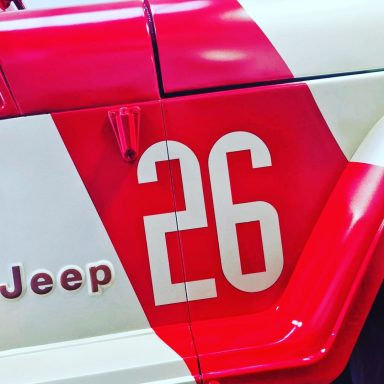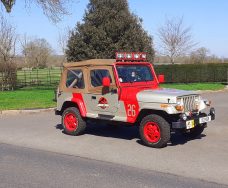Jeep Facts
What kind of Jeeps are seen in Jurassic Park?
The iconic Jeeps used in the 1993 movie 'Jurassic Park' were all latest model 1992 Jeep Wrangler 'YJ' Sahara Editions.
In the original novel, the tour vehicles used to take the guests around the theme park were Toyota Landcruisers and the staff cars were Jeep Wranglers.
For the movie, Ford Explorers were employed as part of a deal with Ford to promote their vehicles.
But the Jeeps remained in the plot as staff cars, and painted with the famous red stripes, in reference to a line in the novel explaining that the Jeeps were painted that way to stop the Triceratops ramming them.
What's the dizzle on a Jeep Wrangler 'YJ'?
Well, the first Wrangler YJ was sold in May 1986 and ran through 1995. This new Jeep was instantly recognisable from it immediate predecessor by its square headlights, a much hated departure from the iconic round headlights, by Jeep fans around the world!
But Jeep were trying to appeal to a new audience who had a good few dollars to spend. The 80's pack.
The call went out to design a new cooler looking Jeep that would appeal to all those surfers and college kids who wanted something a little less agricultural than a Daisy Duke Jeep.
The new Jeep 'Wrangler' was built in Brampton, Ontario, Canada, until 1992 when they were moved to Toledo, Ohio, USA - unbelievably in the same production facilities as the original WWII 'Willys' Jeeps - the grandfather of almost every 4x4 made since, and certainly of all modern Jeeps and yes - even Land Rovers.
Are they rare?
685,071 YJs were built and sold from '86 into '96, so no, not rare in the slightest, and a good 100,000 are still around today. albeit in various states of play and various iterations due to the massive modding scene in the US and elsewhere.
In 1988, the 'Sahara' model debuted- which is the famous model seen in 'Jurassic Park' and 'Jurassic World'.
Soft tops with "half doors", featuring soft plastic zipper windows came standard (windows could be removed completely from these doors). Full-frame doors with conventional glass windows were optional on soft-top models.
Depending on year and interior colour, Jeeps could be had with the top colours in black, white, tan and gray. Roll-bar padding normally matched top colours, with the exception of white tops.
However, to find a good condition, base model and close to screen-accurate Jeep YJ these days is very difficult, especially here in the UK.
Could you drive a new Jurassic Park Jeep straight off the lot?
No, and you still can't.
Amazingly with modern movie ties-ins and product placement, of which there is literally a boat load in JP93 and all subsequent JP and JW movies, Jeep Chrysler never released a JP themed Wrangler YJ.
For Jurassic Park, the 1992 Sahara edition was used with half doors and Spice Tan soft tops, with a dark green interior trim.
4.0 litre, 6 cylinder models were used for filming, employing a Sand Beige Metallic Low Gloss base coat, accented in Ford Performance Red.
The wheels were never standard on the Jeep Wrangler, instead they taken from the Jeep Comanche and sprayed to match the red car paint. The original rims were steelys and considered 'not modern enough' and the production team, as with the Ford Explorers, were told to spare no expense in 'funking' them up for state of the art island life.
They were fitted with a CB whip aerial on the passenger side but interestingly, none of them actually had a CB radio installed, deemed as unnecessary to the scenes and never seen in any interior shot.
They all featured the same green and spice seats with spice door pockets and spice roll bar coverings and soft tops.
Only one Jeep had the roof top flood lights installed, and that is Dennis Nedry's personal Jeep #12. These were fitted on a custom made roof bar and were fully functioning 360 degree searchlights controlled by four joysticks in a row on the passenger side of the dash board. (More on that rather contentious item here)
All 4 screen Jeeps (#10, #12, #18 and #29) were fitted with non-standard fog / spot lights on the front bumper and all were fitted with non-standard Ramsey 6000 winches, but only one is used in the famous 'fetch stupid' where Nedry meets his sticky demise.
My Jeep is modelled after Dennis Nedry's Jeep.
Finally, all Jeeps were fitted with two bright orange fog lights above the rear tail light clusters, for no other reason than Spielberg allegedly wanting 'more light' and 'cooler looking lights' on the rather underlit Jeeps.
The custom finished exterior red/beige colour scheme was in reference to the scant novel descriptions and interestingly against the widespread dislike of the Sand Beige Metallic Low Gloss (or 'candied' as they called it in the US at the time)
paint colour, released by Jeep as an official colour for one year only - never to be repeated.
Which brings a rather large and obvious hurdle to builders of these movie jeeps - where to find the 100% accurate screen paints. More on that here.
So there you have the potted history of the base model Jeep used in two JP movies and the minimum customisation required to make them Jurassic Park staff cars and straight into movie legend as perhaps, next to the Delorean, Batmobile and Lightning McQueen, one of the most recognisable movie related vehicles in the world, based on cinema, Video, DVD, Bluray and streaming figures across 31 years.
And I have one of them!
Facts about JPJeep26
Original Factory Build
Name - Jeep Wrangler
Code - YJ
Version - 1
Model - Sahara
Year of Build - September 1988
Place of Build - Brampton, Ontario, CN
Original Body Colour - Khaki Olive Green Metallic
Original Softop Colour - Spice
Original Interior Colours
- Dark Green Carpets
- Green seats with beige piping
- Ash grey safety dash
- Ash grey dashboard
Original Wheels - Steel rimmed x 5
Original Tyres - P 215/75 R 15
Transmission - Manual 5 speed, selectable 4 wheel drive with rear wheel drive in two wheel mode.
4x4 modes - LS/ LH @117hp
Displacement - 2.5l 4cyl
Top speed - 95mph
Power - 88 kW
Horsepower - 118 bhp
Rev. at Max Power - 5,000 rpm
Torque - 183 Nm
Torque - 135 lb-ft
Rev. at Max Torque - 3,500 rpm
Displacement - 2,464cc
Displacement - 150.4 cu in
Cylinders - 4 Cyl - 2 V per Cyl
Bore - 98.4 mm
Stroke - 81 mm
Compression Ratio - 9.2 :1
Engine Configuration - Inline
Synchronization - Timing Chain
Type of Combustion Engine - Piston
Acceleration, 0-100 km/h - 14.6 sec
Acceleration, 0-60 mph - 14 sec
Length - 3,879 mm
Width - 1,676 mm
Height -1,829 mm
Track, Front - 1,473 mm
Track, Rear - 1,473 mm
Wheel Base - 2,373 mm
Turning Circle - 10 m
Number of Bolts - 5
Bolt Distance - 114.3
Nut/Bolt Dimensions - M12x1.5
Central Bore (CB) - 67.1
Fastening Type - Lug Nuts
Rim Type - Disc Wheel
This specific vehicle was built for European Export and was fitted with European Headlights, tail lights and indicator/ side light modules - none of which are standard fittings.
It was shipped to Hamburg North Germany in November 1988 to a Chrysler Dealer and spent the first 12 years of its life under 5 owners in the North Western of Germany.
In 2001 it was imported to the UK and spent 14 years with one owner in Hampshire before being bought by a Chrysler dealer in North London.
It sat awaiting an overhaul for 5 years when it was purchased by a local movie industry worker who had plans for it as a Jurassic Jeep base model.
I purchased it in the summer of 2022 with no plans whatsoever other than to drive it about as is.
Part Two
That plan didn't last too long.
We need your consent to load the translations
We use a third-party service to translate the website content that may collect data about your activity. Please review the details in the privacy policy and accept the service to view the translations.

